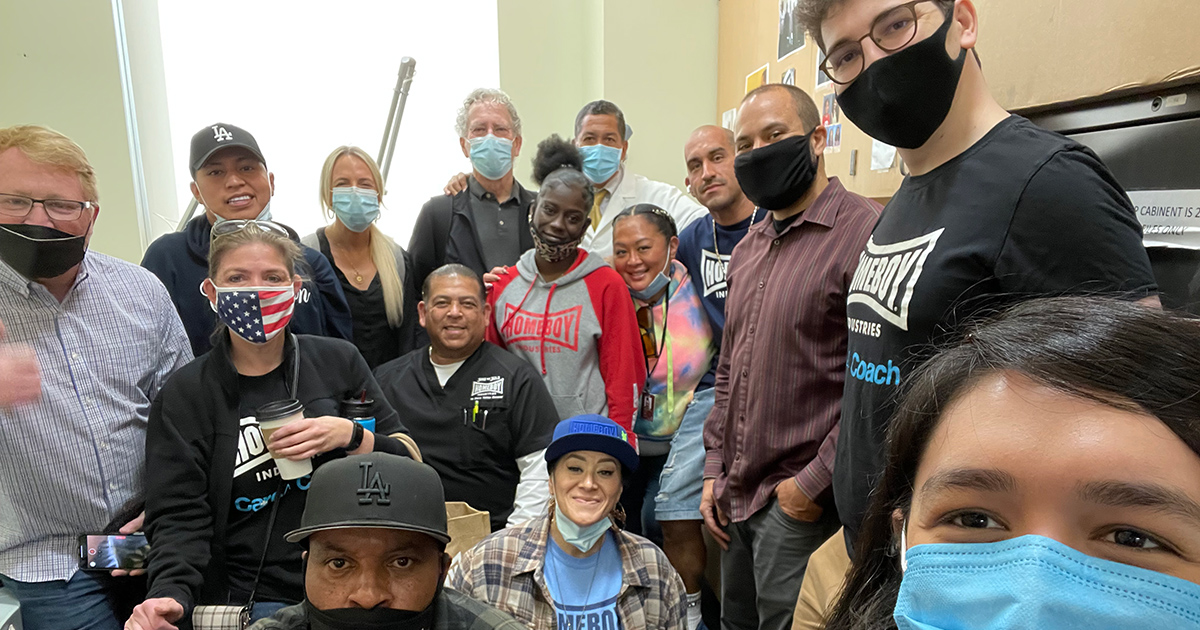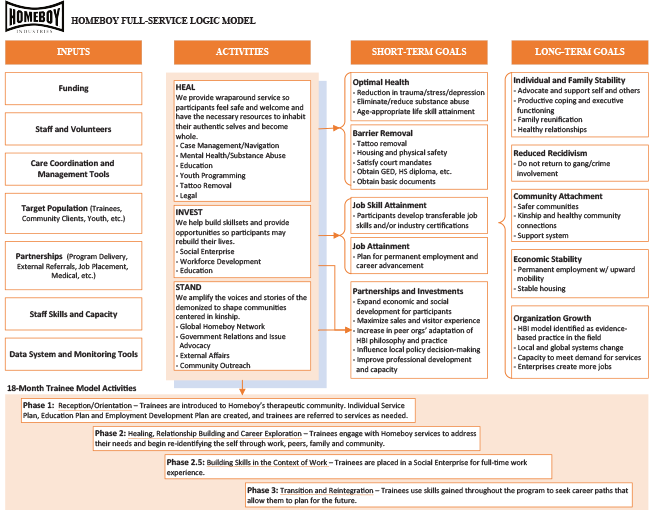Lessons from the Field: Integrating Data and Technology into Client-Centered Services at Homeboy Industries

Nonprofit program providers have many reasons to use data systems, from monitoring client progress to reporting on who was served to identifying needs and service gaps. As the technological capabilities and accessibility of data systems advance, organizations can use these powerful tools to strengthen program design, implementation, and results measurement over time.
For example, Homeboy Industries (HBI), one of the largest gang rehabilitation and reentry organizations in the world, is transforming its data infrastructure and the way it uses technology to better support its client-centered program services. MDRC recently collaborated with HBI on a project to establish program logic models and to assess the organization’s data collection needs and practices, with funding support from the Annie E. Casey Foundation. This blog post draws on what was learned from that collaboration.
About Homeboy Industries
Homeboy Industries provides comprehensive, individualized services to individuals in Los Angeles County who were previously gang-involved or incarcerated. HBI’s open-door culture focuses on building strong relationships with clients and allowing them to determine their own needs and goals. The organization offers a range of services, such as tattoo removal, workforce development, substance abuse treatment, and mental health care, with a commitment to building a community of support with “those whose burdens are more than they can bear.” HBI currently serves about 8,000 clients each year.
Staff members across the organization have considerable autonomy in how they tailor services to suit their clients’ needs, avoiding a one-size-fits-all approach to case planning. But this flexible approach, coupled with an aging data system, has created challenges in recent years, as organizational leadership has looked for ways to establish consistent procedures and to improve data collection practices. As HBI continues to grow and seek out new funding opportunities, data gathering and measurement capacity has become increasingly important.
To serve the high volume of clients, program leaders wanted to empower staff members by giving them better, more accessible information they could use to monitor client progress, and to support more nuanced reporting on program outcomes. A data system upgrade was in order.
Getting Ready: Articulate Goals and Needs
Integrating new data systems into existing program operations can be difficult for any organization. To ensure a strong transition, the process requires careful planning by organizational leadership and clear expectations for system developers.
To start, organizations should be clear about their goals for using a new data system. In its work with MDRC, HBI staff laid out multiple goals they wanted to meet:
- manage the volume of clients coming through program services
- monitor client participation in services over time
- measure client experiences using screening tools or assessments
- help program leadership make informed decisions about what is working and what to change
- report on program accomplishments and client outcomes for funders and external stakeholders.
MDRC worked with HBI to create an organization-wide logic model as well as one for each of its departments. A logic model is a document that breaks down a program’s essential components and activities that are understood by the program to contribute to positive outcomes. Using the logic models as a starting point for focused discussion, HBI worked to align staff members’ understanding of program goals and to reach agreement about what data were meaningful and useful to understand and serve their clients better.
Making a Plan: Secure Staff Time and Put Resources in Place
After articulating what to measure and the reasons for doing so, it was time for HBI to make a plan. Implementing a new data system requires more than a technology platform; it also involves managing vendors, training staff, overseeing the change management process, and dealing with unanticipated challenges that come up along the way.
Executing this organizational shift at HBI required an investment in staffing resources and support from both internal and external partners. To lead this effort, HBI hired its first chief of education and research as part of its commitment to improving data collection and outcomes reporting. HBI also hired a data analyst to be a liaison between HBI and its external partners. The additional staff members were especially helpful at HBI due to the scale and complexity of the services offered and the limitations of the organization’s existing data capacity.
Ideally, staff members in a variety of roles should be involved in the process, to build shared understanding of program goals and the information needed to strengthen programs. HBI’s staff was significantly involved in setting expectations with the organization’s software vendor, providing input on customization of features, testing the technology, and refining processes related to data collection. During the early planning stage, MDRC supported HBI’s efforts by gathering staff input and providing an initial assessment of priorities to inform the selection of a new data system.
Choosing the System: Select the Right Technology Partner
The value of a data system can go well beyond tracking data about client outcomes. With the move to cloud-based technology, these systems can more seamlessly integrate into and improve the day-to-day functions of program services.
HBI chose to adopt a therapeutic case management database, Care4, to replace its current system. The organization chose Care4 because it could be customized—an essential feature that could dovetail with HBI’s flexible approach to service delivery. A customizable system meant that staff members could accurately monitor client progress through multiple HBI programs and report on key performance metrics in real time.
When selecting a vendor, organizations may want to ask the following questions to understand what the partnership might be like:
- What steps need to be taken before work begins with the vendor?
- What is the expected timeline for planning and launching the new system?
- What kind of training is offered?
- What kind of ongoing support is available?
- What was the experience like for similar customers?
In some cases, organizations may be satisfied with selecting out-of-the-box software that is faster to launch but less tailored. If the vendor will not be as involved in the change management process, consider hiring a consultant to add short-term support and capacity.
Coming Next: Insights on HBI’s Change Management Process
Homeboy Industries began to implement their new Care4 system in early 2021. Stay tuned for our next post, which will explore the change management process HBI has undertaken. It will also share insights on what organizations might expect when a new system is launched in terms of training staff, fostering internal information sharing, and integrating data into daily decision-making.






